Definition of 8-core cable
When it comes to fiber optic cable connections, people will use various terminology to describe the type of connector used in fiber optic cable and the number of fiber cores. 2-core cable is easier to understand and identify. When using a 2-core connection, the cable is in two fiber increments, such as a common LC duplex or SC duplex connector.
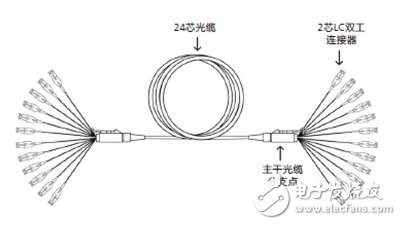
figure 1
2-core system example using a 24-core trunk cable
In comparison, when using fiber optic cable with 12-core connection technology, the 12-fiber MTP© connector is used in increments of 12 fibers. Recently, 8-core connectivity solutions have begun to emerge. The 8-core system will still use MTP type connectors, including eight fiber connectors, but in the manufacture of fiber optic cables in eight fiber increments. For example, in an 8-core system, there is no trunk fiber for 12-core fiber, but a trunk cable with 8-core fiber, a trunk cable with 16-core fiber, a trunk cable with 24-core fiber, and a backbone cable with 32-core fiber; all 8 Core trunk cables are all in increments of eight. The difference between the 12-core and 8-core cables is shown in the figure below.
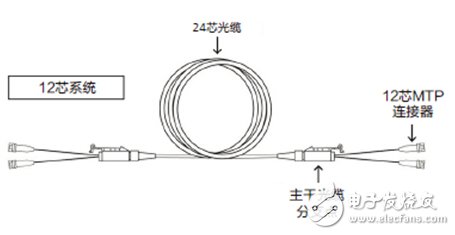
Figure 2A
12-core system example using a 24-core trunk cable
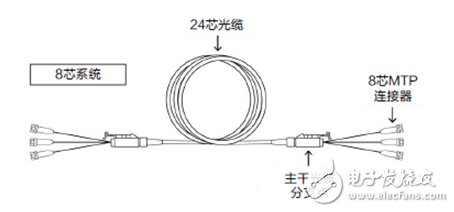
Figure 2B
8-core system example using a 24-core trunk cable
Review: The origin of the 12-core cable
The 12-pin connection technology was introduced in the mid-1990s and was jointly launched by IBM and Corning. At the time, the two companies were developing a modular, high-density structured fiber optic cable system that could be quickly deployed to the data center while achieving maximum port density in the rack. After the data center has evolved from only a few fiber connectors to tens of thousands of fiber ports, the jumper of two-core fiber in the data center is obviously a messy situation with unmanageable and poor reliability. Since the TIA/EIA-568A fiber color coding standard is designed for 12-fiber fiber optic cables, high-density connections can be used to achieve digital 12-incremental connection technology, so 12-fiber MTP connectors and 12-core cables Connection technology came into being. Since then, trunk cables with 12-core fiber and even 144-core fiber have been introduced and deployed worldwide. The 12-core trunk cable is generally used for the backbone of the network, indirectly from the main wiring and connected to the partition wiring area. At this time, the amount of the optical fiber is large, and the optical cable is used at a high density. Most fiber ports require two fibers to connect to ports on servers, switches, and storage devices. Therefore, 12-fiber to 2-core fiber-optic wiring modules and branch jumpers are required to provide two cores for two-fiber ports. The interface of the fiber. Since the number 12 can be divisible by the number 2, we can easily provide a two-core fiber interface for network equipment to achieve a complete fiber optic application for a 12-core trunk cable.
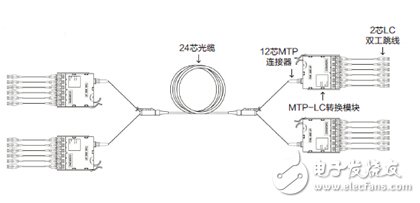
image 3
Show a 12-core trunk cable access module, converted to a 2-core jumper
The rise of 8-core cable
In the past 20 years, 12-core fiber optic cable connection technology has been providing quality services to the data center industry. Due to the rapid deployment of MTP connectors for 12-core fiber in recent years, MTP has become the established standard in many data center trunk networks. But the times are changing, and the recent 8-core connection technology is becoming more common. On the one hand, this is due to the shift in the types of transceivers used by switch, server and memory manufacturers in the device. On the other hand, the development direction of the transceiver is guiding the industry from 10G Ethernet to 40G, 100G or even 400G.
Technological innovations in the field of transceivers are changing rapidly, but anyone who has installed a 40G line knows that one of the most common types of transceivers, the QSFP transceiver, uses an eight-core fiber optic cable. We can connect to the QSFP port using a 12-pin connection technology, and in fact, many people using 40G lines now use 12-pin connection technology in the trunk network. However, as long as anyone who has studied basic mathematics knows that plugging a 12-core fiber connector into a transceiver that requires only eight core fibers means that four fibers are not useful. Some solutions on the market implement 100% full utilization of the backbone fiber through a 12-core to 8-core cable conversion module or branch jumper, but this adds additional MTP connectors and insertion loss to the cable. In general, this is not the best solution in terms of cost or cable performance, so the industry recognizes the need for a more reasonable solution.
This solution is an 8-core fiber optic cable connection technology. After talking with mainstream transceivers, switches, servers and storage manufacturers, we learned the obvious fact that the current, near-term and future long-term will be the era of transceivers that support 2-core or 8-core fiber-optic cable technology. . In other words, the trend of 40G-400G Ethernet data transmission is the connection solution of two and eight fibers.
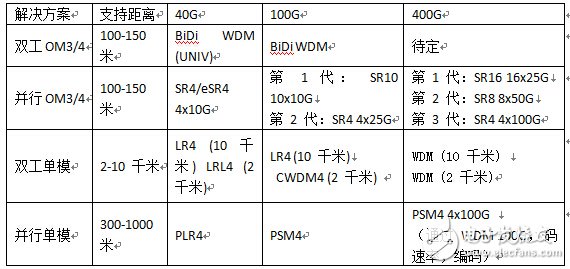
Figure 4 – 40/100/400G Technology Trends
As shown in the above figure, some short-lived solutions will be adopted in the process of developing to 400G, such as the first-generation and second-generation OM3/OM4 parallel transmission technologies. 32-core and 16 are recommended in this technical solution. Core cable solution. But Corning, after talking with renowned transceivers, switches, servers and storage vendors, learned that due to manufacturing costs and connector complexity (for example, you really want to add a 32-fiber connector to your network). ?), people do not want to use this solution widely. Therefore, for 400G networks that implement parallel transmission over OM3/OM4 fiber, the third-generation solution—the 8-core fiber-optic cable solution is expected to gain widespread market acceptance.
Because the number eight can be divisible by the number two, the 8-core cable backbone connection technology can be easily applied in a two-core fiber transceiver system like the 12-core cable connection technology. At the same time, 8-core fiber optic cable technology provides the most flexibility for the most widely used 40G, 100G and 400G transceivers, while the 12-fiber cable connection technology is not the best solution for eight fiber optic transceiver systems. In short, the 8-core fiber optic cable connection technology is the solution that best meets the future 400G data transmission requirements.
Can 8-core and 12-core cables be used simultaneously?
This is not necessarily true. It depends on our understanding of "simultaneous use". If you think of it as mixing components directly and plugging an 8-core trunk cable into a 12-fiber module, the answer is definitely "no." Depending on the intended use, the two components cannot be plugged directly into each other. Similarly, the 12-core and 8-core cables are designed to look different, so you cannot mix 8-core and 12-core cables in the same cable connection. Cable assembly. One major difference in appearance between the two types of fiber optic cables is that the connectors at both ends of the 12-core trunk cable typically do not have a positioning pin and require the use of a wiring module with a positioning pin. However, the new 8-core trunk cable has connectors on both ends that are manufactured with positioning pins. Therefore, the 8-core trunk cable must not be plugged into the 12-fiber cable connector, as this means we are trying to connect two connectors with positioning pins. This change in the backbone cable plug solution is due to the advantage of ensuring that connectors with no pins are always used on both ends of the 8-core cable MTP jumper whenever the fiber optic cable is used in the network. This simplifies network deployment and eliminates the need to purchase a large number of MTP jumpers with locating pin headers.
However, if “simultaneous use†is understood to mean the simultaneous use of 8-core fiber optic cable and 12-core fiber optic cable connection technology in the same data center, the answer is “yesâ€, but there is a condition. This condition is that the 8-core cable and the 12-core cable must be used separately, as we have mentioned earlier, the components of the 8-core cable and the 12-core cable are not interchangeable themselves, and in the same cable link, 8-core cable and 12 The core cable assemblies cannot be plugged into each other's components. Therefore, care should be taken when managing the data center physical layer infrastructure to ensure that 8-core and 12-fiber assemblies are not mixed in the same cable link.
Comparison of 8-core cable and 12-core cable: How to choose?
Because 12 is significantly larger than 8, the 12-core cable connection technology does have an advantage in connector fiber density compared to the 8-core fiber-optic connection technology, so a large number of fibers can be installed faster with the 12-fiber cable connection technology. However, due to the larger number of 40G and 100G lines deployed, and the eight fiber-optic transceivers used in these lines, the advantage of keeping the number of fibers in the MTP backbone connection technology consistent with the number of transceiver fibers is better than 12 cores. The density advantage of fiber optic cable connection technology. In addition, when using the MTP-to-LC duplex branch jumper to connect to the switch line card, the 8-pin branch jumper can be easily routed to all common line card ports because the number of ports for all common line cards can be divisible by the number four (Because the 8-core branch jumper provides a four-way LC duplex connection). In the case of a 12-pin branch jumper that provides six LC duplex connections, these branch jumpers cannot be easily routed to a line card with 16 or 32 ports because the numbers 16 and 32 cannot be divisible by the number six. The comparative advantages of 8-core fiber optic cable and 12-core fiber optic cable connection technology deployed in the data center are detailed in the table below.
8-core cable advantages
The best choice for two-core fiber and eight-core fiber transceiver technology
Ensure that the eight-core fiber transceiver system achieves 100% fiber utilization, and that the 12-core to 8-core cable conversion equipment does not add additional cost and insertion loss.
Branch jumpers can be easily routed to all common line card ports on the switch
When making any connections in the link, only MTP jumpers without positioning pins are required
The most flexible solution for 40G, 100G and 400G data transmission networks
Advantages of 12-core cable
Higher density of fiber for each connector than 8-core cable
Compatible with large-scale core counts for existing 12-fiber MTP deployments
While the fiber density used by each connector is not negligible, most people are more concerned with how to migrate to 40G and 100G faster. Anyone who plans to migrate their data centers to 40G or 100G networks in the near future will find an advantage in using 8-core fiber optic cable connectivity.
Conclusion
In the next few years, the data center will continue to use 8-core fiber optic cable and 12-core fiber optic cable connection technology. Both approaches have their own advantages and each has a place in the data center, and the use of 40G and 100G data transmission is a key determinant. If your data center is using 12-core fiber optic cable technology and you feel satisfied, you can rest assured that you will continue to use the 12-fiber cable connection technology. 8-core fiber-optic connection technology is just one option in the network designer's toolkit, which ensures that the data center is optimally cost-effective, has a network that meets future needs, and easily migrates to a 400G transmission network.
Bear ear headphone is a patented headphone designed exclusively by LINX Headphone Factory, which has Chinese and EU patents. On the basis of ordinary headphones, plus bear ears, it is more lovely. The earphones emit LED lights, and the lights can be freely controlled. There are 4 ways: flash with the rhythm of music, flash, steady and light off.
Advantages:
1. Bear ears, exclusive private model patent, cute shape.
2. LED colorful light.
3. Multiple colors, can be mixed batch.
4. Stock, 24 hours delivery.
5. Colors can be customized freely.
6. Wired Bear Ear Headphones and Bluetooth bear ear headphones are optional.
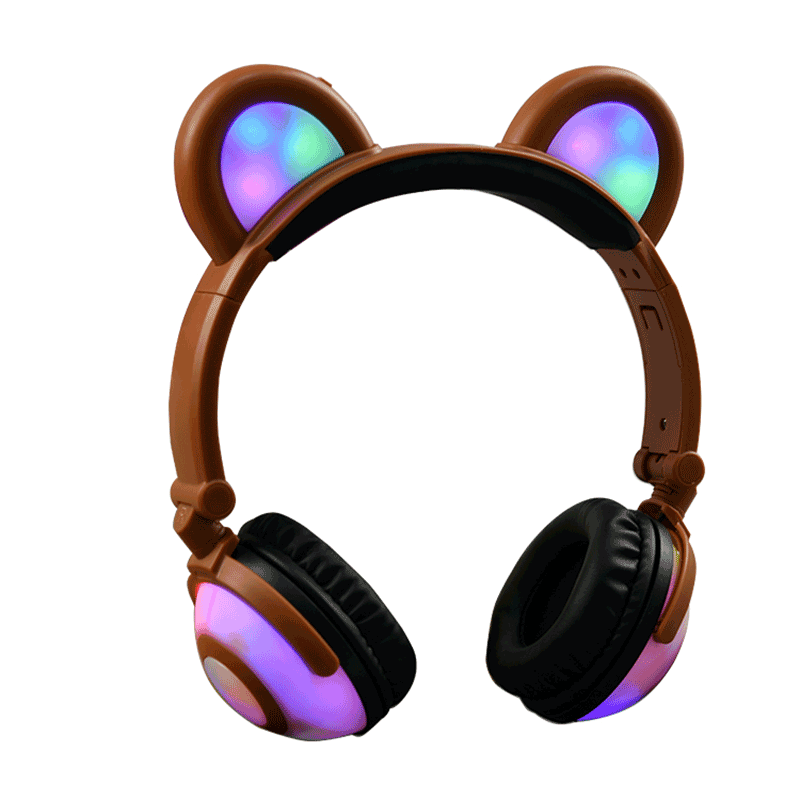
Bear Ear Headphones
Bear Ear Headphones,Bear Headphones,Bear Earphones,Bear Ear LED Headphones
Shenzhen Linx Technology Co., Ltd. , https://www.linxheadphone.com
